Logistics app development may seem like a daunting task. Besides, why create such an application from scratch if there are ready-made solutions? Eventually, how to properly build such a complex logistics management system?
In this article, we’ll concentrate on how to develop logistics software for your company, revealing all the reasons and ways of this process. The app will provide you with better control, up-to-date accountability instruments, and AI-powered automation and optimization solutions.
Let’s start with a quick overview of the logistics app definition and the way it works.
Table of Contents
- 1 What Is a Logistics App and How Does It Work?
- 2 Let’s Overview The Logistics App Market
- 3 Why Does Your Transportation Business Need a Mobile App?
- 4 Types of Logistics Apps
- 5 Logistic App Features You Should Pay Attention to
- 6 How to Make a Logistics App Step-by-Step
- 7 Technology Stack for On-Demand Logistics App Development
- 8 How to Earn Money with Logistics Applications?
- 9 Logistics App Development Cost
- 10 Conclusion
What Is a Logistics App and How Does It Work?
Logistics management is a critical and complicated part of any business, and it requires 24/7 monitoring services for tracking, order delivery, and scheduling. It involves a lot of paperwork. It is often very hard for enterprises to manage logistics. To simplify logistics management, the implementation of a mobile application may be a good idea for the entrepreneur.
Logistics apps help a lot of the retail industries as they enable them to run their day-to-day business reasonably efficiently. These applications can manage many things such as fleet tracking, transportation, shipment management, real-time monitoring, analysis, and more. Thus, this kind of app successfully helps industries to carry out their business operations.
Let’s Overview The Logistics App Market
The logistics industry worldwide will grow by $287.1 million between 2020 and 2024, according to MarketWatch research. This means that the CAGR will grow by 5 percent. Even the annual growth rate is estimated at 4.13% for 2020 by the end of the forecast period. The CAGR is considered the highest between 2019 and 2023.

Another report from Transparency Market Research says the logistics industry will be worth $15.5 trillion by 2023, which says a lot about the bright future of the on-demand logistics industry.
Besides, analyzing the statistics of the transport and logistics industry shows that the share of logistics/cargo transportation has the highest market share of 35%.
According to the Logistics Performance Index, China is a leading emerging market with a score of 8.9. This is followed by India (7.39) and the United Arab Emirates (6.36).
What Are The Most Well-Known Logistics Apps?
While an on-demand delivery application has its advantages, several other large companies provide a useful logistics application for your business as well. Let’s take a look at them.
- DHL Express
The DHL Express mobile app lets you track and manage your shipments in one place. You can find the nearest DHL service point to receive or send your parcel, and quickly check shipping costs – right on your smartphone. Advanced GPS positioning services and camera barcode scanning are also available. Download DHL Express Mobile today.

- XPO Logistics Inc.
XPOLogistics prioritizes customer experience by developing robust applications, especially for the customer experience of the previous mile. They also monitor the level of satisfaction at the time of delivery. When people buy a refrigerator, exercise bike, or any other large item, they can track their order in real-time. What’s more, they can change the delivery schedule electronically and can also set personalized alerts. The calibre of their technology is the main reason why retailers, e-commerce organizations, and manufacturers use XPO on the “last mile”. - Carrier 360 by J.B. Hunt
Moving electrically powered only loads is a great way for carriers to keep costs down and find stable loads. J.B. Hunt prioritizes carrier expertise, which means ensuring airlines have access to the information and tools they need to operate efficiently. If you have a fleet of vehicles, you can register your drivers with Carrier 360 and send loads in the app. - C.H. Robinson Worldwide
Whether you are a start-up business or a solid organization, Robinson’s free Navisphere Carrier mobile app will help you control many aspects of your business. You can control current loads, driver assignments, document processing, and much more. With a combination of available tools, you’ll quickly notice fewer test call problems, more natural boot scheduling, more informative notifications, and best of all, you can leave your bulky computer at home. - UPS Supply Chain Solutions
A turnkey UPS multi-carrier supply chain solution helps customers manage shipping processes. It also controls costs and provides online flexibility. The application can more efficiently manage delivery to one or more locations from warehouses, distribution centres, or retail stores.
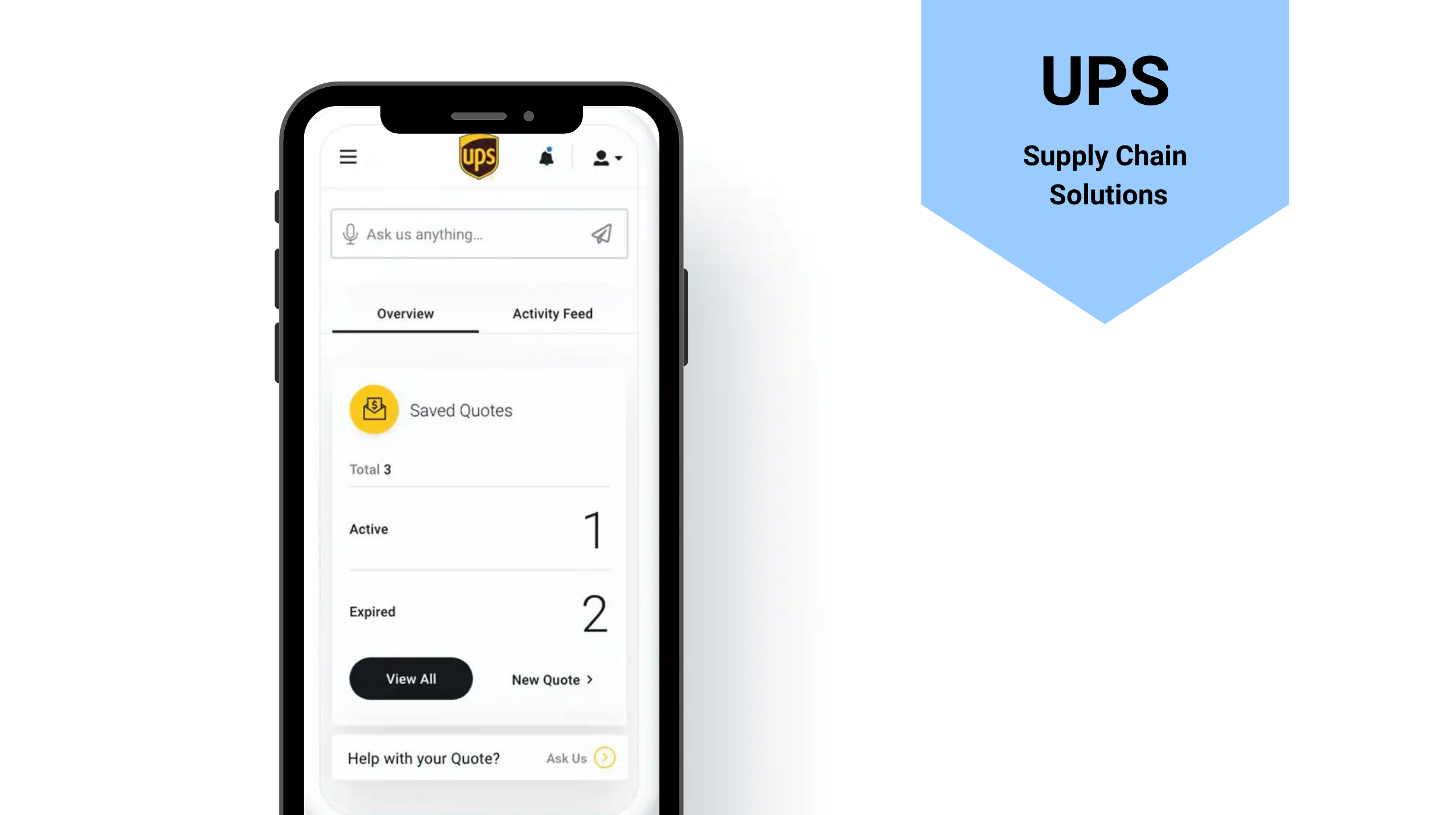
- Cargomatic
Cargomatic is a logistics company founded in 2013 by Brett Parker and Jonathan Kessler of Long Beach, California, specifically targeting fragmented short-haul and freight markets, connecting shippers and carriers in real-time through its crowd shipping web platform and mobile app.
Why Does Your Transportation Business Need a Mobile App?
Logistics companies need to integrate a mobile app strategy into their workflow to reap the following advantages:
✅ Eliminates paperwork
Mobile apps provide instant access to the company’s database of cargo accompanying documents, avoiding inconvenient paper forms of orders and service orders.
✅ Decrease the time and cost of delivery
With mobile fleet management solutions, you can plan deliveries, predict fuel costs and reduce empty miles.
✅ Optimizes dispatch and routes
Mobile warehouse management solutions with built-in databases and barcode scanning capabilities improve shipments, while shipping scheduling gives you the flexibility to select the best method in advance.
✅ Provides control over the vehicle management
You can get more coordinated delivery and accurately predict if your vehicle is shipped with the built-in GPS tracking feature in the driver logistics app.
Simply put, you can use mobile technology to automate day-to-day tasks, manage shipping inventory in real-time, and provide transparency to all departments, thereby reducing empty miles and increasing profits.
Types of Logistics Apps
Since logistics applications vary in purpose, end-user, and feature list, you should decide which type of app you want to create:
🔹 Mobile applications for fleet management
If you have a large fleet of trucks, the Fleet Management System will help you register, manage and store all your truck data. This transportation logistics software allows you to track important metrics such as vehicle maintenance history, maintenance costs, and fuel consumption. This will give you a deeper understanding of your overall spending.
Fleet management apps include a driver app and a web admin app. The driver app allows users to update vehicle information. The admin app allows you to assign a user role, track your fleet statistics, schedule reminders, and more.
🔹 Mobile applications for logistics on demand
On-demand delivery logistics applications connect vehicle drivers with shippers who need to deliver goods. Thus, the application consists of the operator application, the sender application, and the admin panel. Such an application works as follows: the shipper sends a delivery request, then the platform notifies the nearest free driver. After the driver picks up the goods, shippers can track the location of the vehicle using GPS. After the delivery is complete, the application notifies the sender of the successful delivery and sends an invoice.
To make money, there is a software maintenance fee based on total shipping when delivering applications on demand.
🔹 Warehouse Mobile Apps
To ensure that the packages are delivered to the right place within the specified time frame, we recommend that you consider developing a barcode scanning application.
Third-party APIs allow such applications to define various barcodes and integrate them with your store’s database for real-time updates. In addition, barcode scanning applications reduce the cost of barcode scanners and decrease the number of human errors. In short, barcode scanning can improve the efficiency of warehouse employees.
🔹 Tracking and shipping applications
Tracking and shipping apps provide real-time route and shipping data. They also display the current location of the drivers.
After you have collected all the required data about your mobile logistics application, it’s time to look for mobile application developers.
How to Make a Location-Based App Tailored Exactly to Your Needs
Logistic App Features You Should Pay Attention to
When developing a logistics application, three panels need to be designed and developed. Let’s take a look at each of them, discussing the must-have features of a logistics application.
User Panel
✔ Registration
It’s possible to develop a registration in two ways. The first one is by building a new account altogether. The second is by registering with existing social media accounts. Providing this option to users will make a good impression.
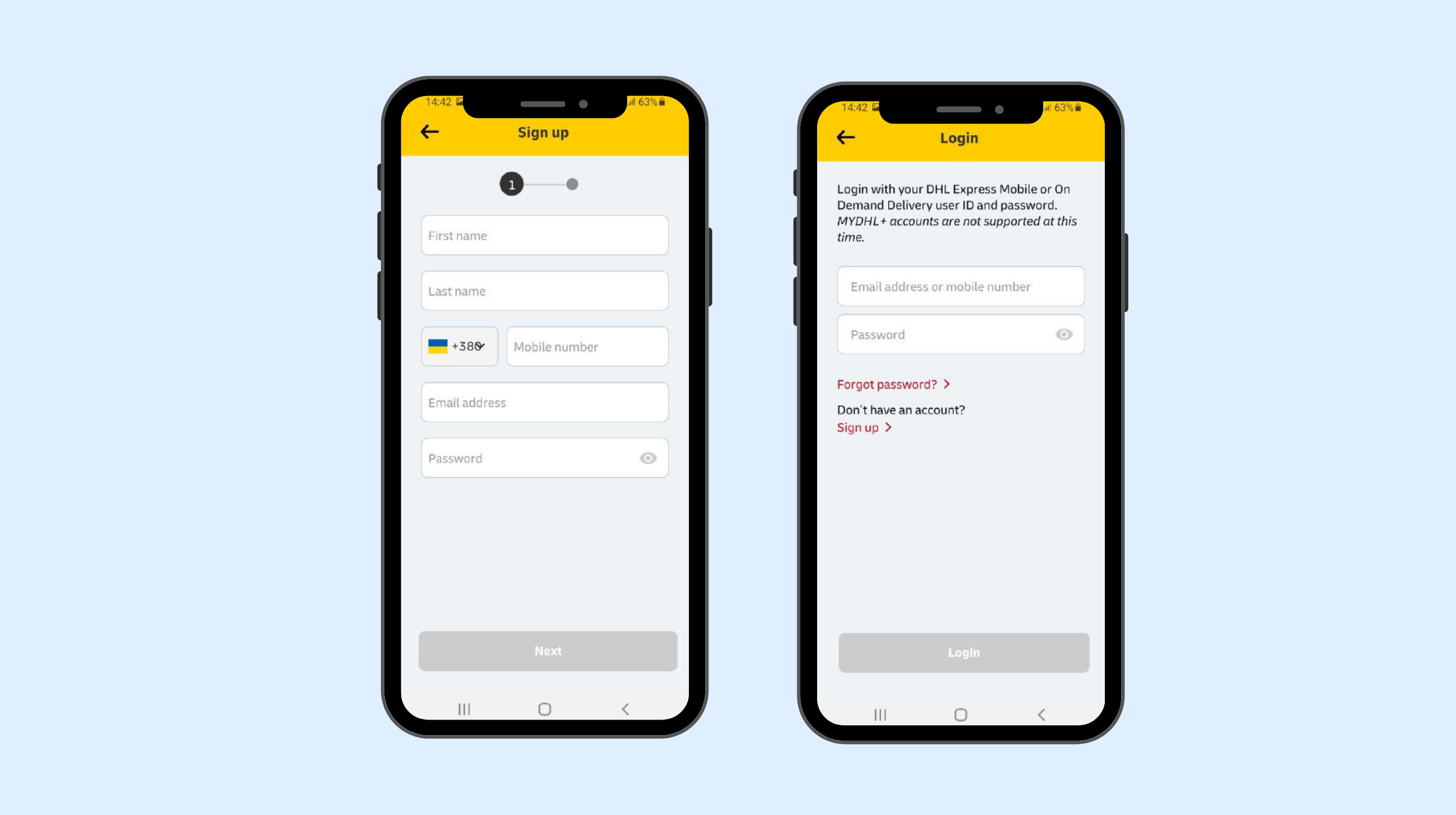
✔ Car selection
It’s a critical feature for integration into on-demand logistics applications. It helps users to select a vehicle according to their requirements, such as a van, truck, trailer, container ship, etc.
✔ Planning and managing your booking
Here users will be able to book a car to immediately use the services, as well as make a preliminary order, indicating the date, time, and place of collection.
✔ Numerous payment gateways
The more options you provide to your user, the better experience they get. This is also true in this case. Allowing customers to pay for services with a credit/debit card, online wallets, and more will promote them to use your application more often.
✔ Tracking the shipment
Rather an important feature, a tracker is what your users already expect from your transportation and logistics application. So don’t forget to implement this in your final product.
![]()
✔ Return location
Always allow customers to enter their pickup point manually or using GPS.
✔ Real-time alerts
Push notifications are a great way to keep users informed about useful and important information by engaging them in your app.
✔ Estimate the fare
Users need to know in advance how much they have to pay for the service. In this case, using the built-in rate calculator will be extremely useful. He will calculate the cost of services based on the size and weight of the parcel.
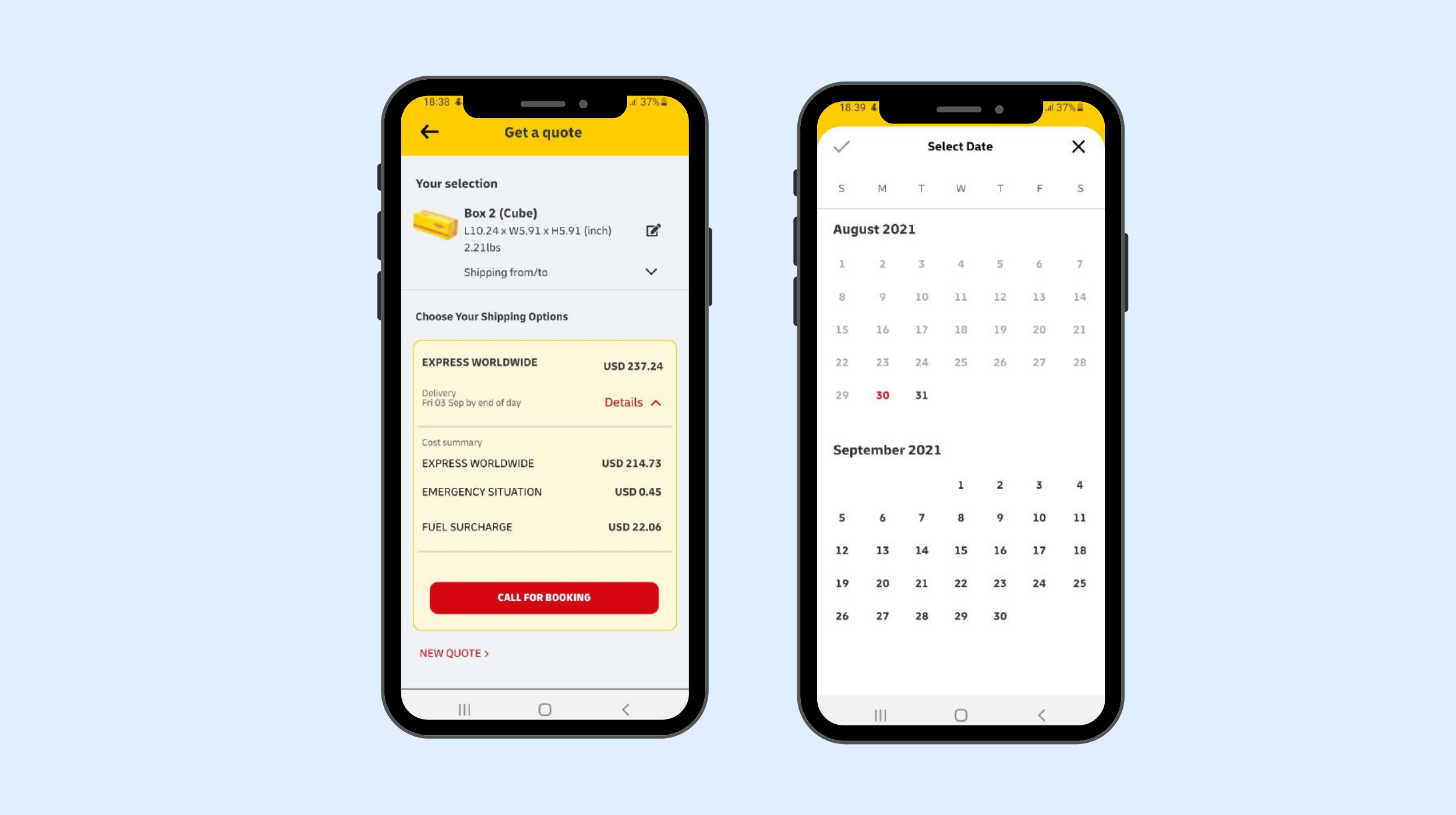
✔ Access to history
This feature will allow users to revise their previous transactions and invoices to track and record everything.
✔ Ratings and reviews
Users would appreciate it if they found this feature in your application. Thus, people can rate and check the services, as well as leave reviews that can help other users.
Driver/Dispatcher Panel
✔ Login/Register
Like users, drivers can register using their existing email IDs or social media accounts.
✔ Managing requests
This feature allows drivers/dispatchers to accept or reject any request or order based on their preference.
✔ Make available or busy
It will help drivers or dispatchers show their availability/unavailability for services using a variety of options such as flagging their availability, etc.
✔ Departure details
Getting information about the delivery of a shipment is an important element that will help your application become popular if you take on the job.
✔ Profile Management
Probably one of the most basic functions is to allow drivers to update information in their profiles.
✔ Navigation
This is an essential function for the driver/distributor side of the logistics application. It provides information on the best route to customer addresses to facilitate timely delivery.
✔ Mark delivery
Allowing the dispatcher this function will allow them to send alerts to both parties (client and administrator) about the delivery of the package.
✔ Delivery Details
With this function, the dispatcher/driver can easily access all the details related to freight (product weight, fuel consumption, distance travelled, tolls) and delivery (name, address, contact number, destination).
✔ Access to history
It would be better to suggest this feature as it will help them review past transactions and invoices.
How to Build a Rideshare App: Types, Features, Cost and Challenges
Admin Panel
✔ Dashboard
It displays all important information regarding riders and drivers. The administrator can also see pending and completed orders with real-time data.
✔ Fleet/Vehicle management
With this feature, the administrator will be able to introduce new vehicles to send and even update existing parts with images, etc.
✔ Manage invoices and payments
With this account management feature, the administrator will be able to create and update accounts. In addition, the administrator can also manage payments, that is, approve payments received by drivers and analyze other similar transactions.
✔ Driver monitoring
This feature helps manage and assign tasks to drivers/dispatchers, and track their travel times, activities, and pending requests.
✔ MS Features
As part of this function, all user requests related to services or drivers, as well as any improvements requested by users, are recorded and processed by the administrator.
Extra Features
✔ Get a quote
Based on the offers and services available, people can request a quote from the service provider to get an idea of the cost and timing of the service.
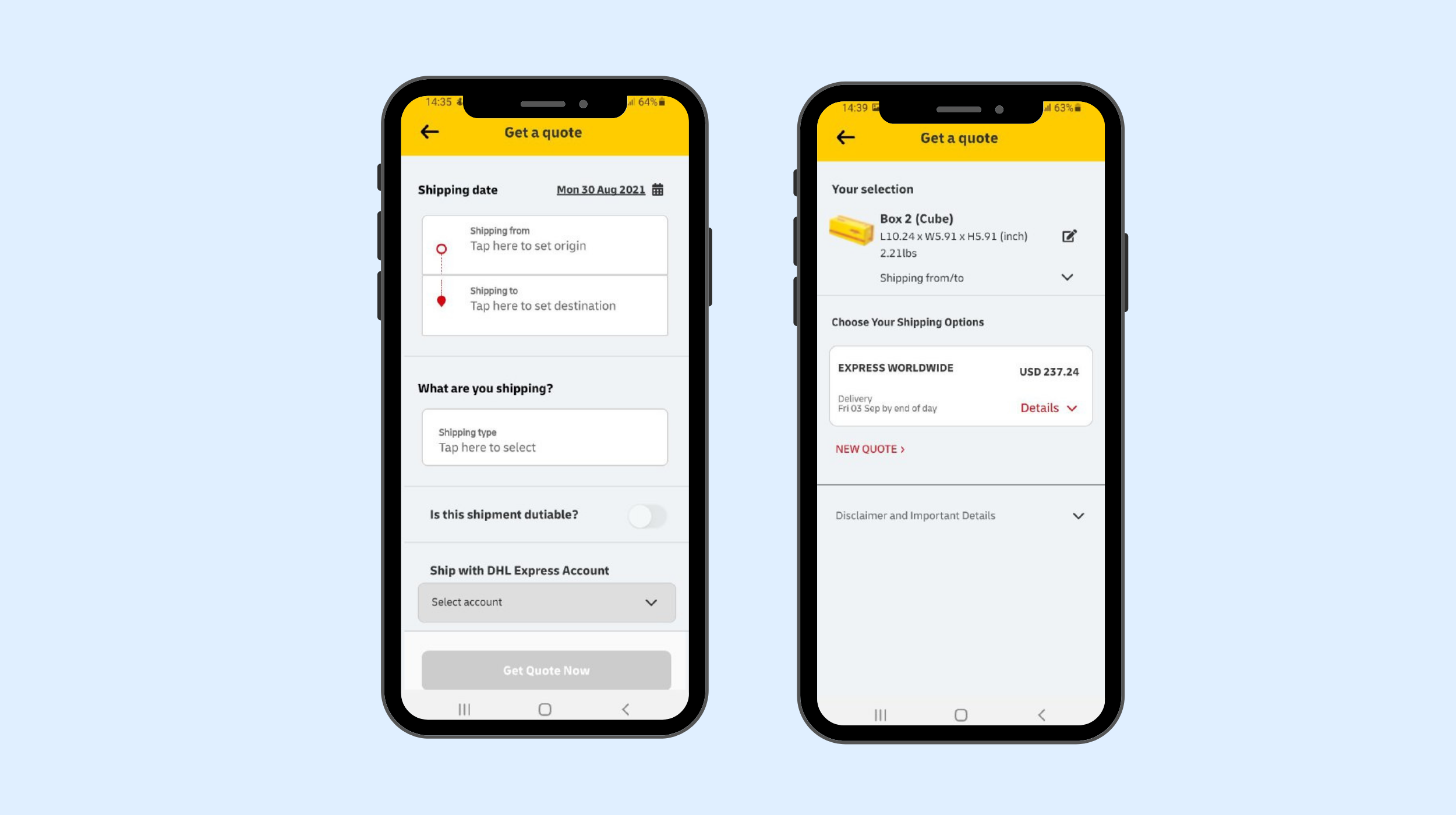
✔ In-app chat
This may be an optional feature, but it is also important. This will simplify the work of your users as they don’t have to look for another resort to contact the service provider.
✔ Chat support
Chatbots are now playing a huge role in the B2B and B2C sectors. Most of the apps that provide any kind of service or product are equipped with chatbot app development. This is what we at Appinventiv highly recommend.
✔ Multilingual support
Multilingual support, widely known as the practice of localizing mobile apps, can increase the popularity of your app around the world.
✔ Link and upload documents
For dispatchers, this feature will be a great success as they will be able to upload important shipping-related documents such as insurance documents, etc.
Now that we’ve finished getting to know the critical aspects of the logistics industry and application development, let’s get down to the stages of building logistics applications.
How to Make a Logistics App Step-by-Step
We have compiled the main stages of developing a logistics application, to make clear the application development process.
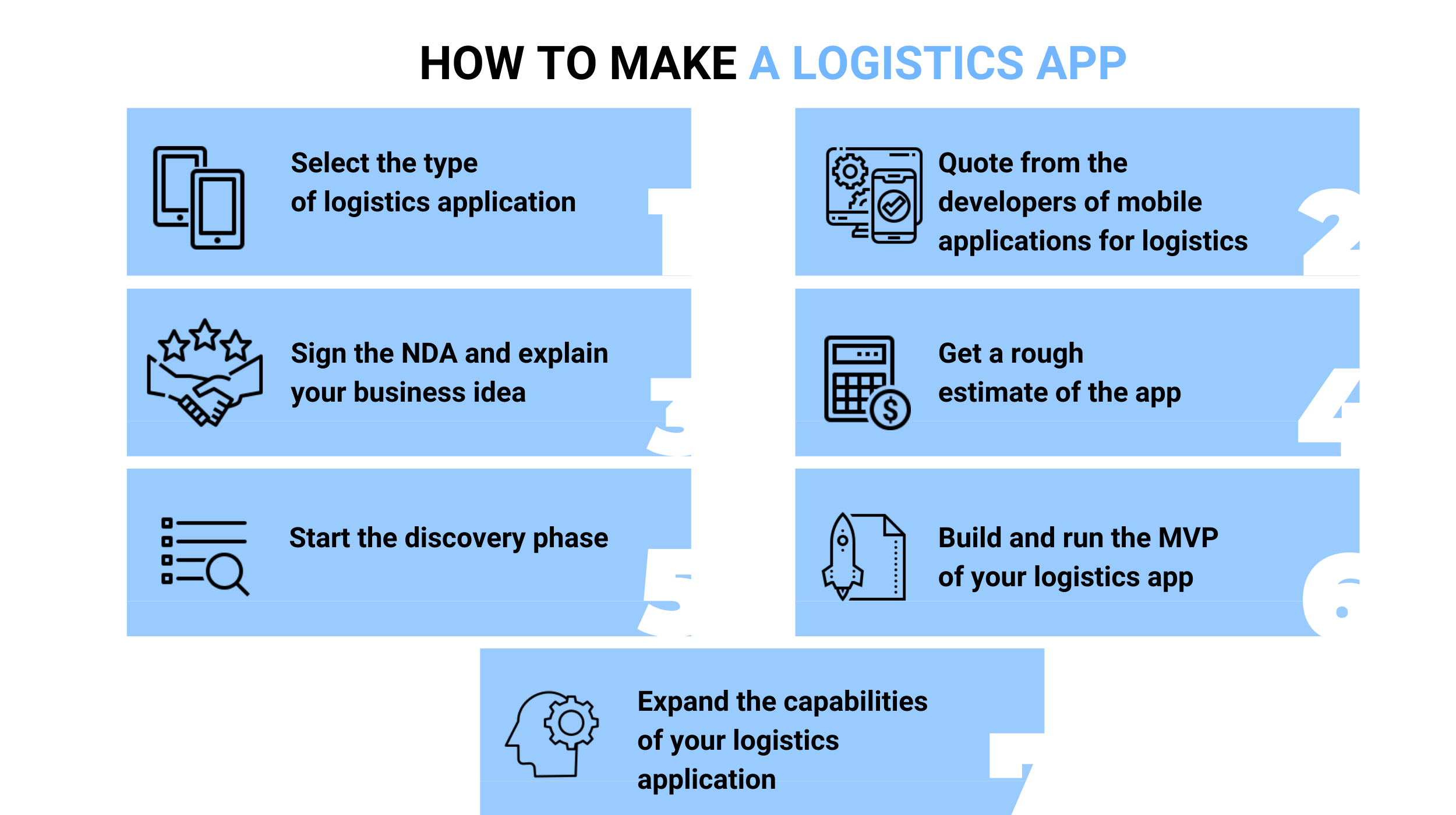
Stage #1. Select the type of logistics application
As logistics involves numerous departments, logistics apps are also various in goals, end-user, and feature list. That’s why you need to decide what type of application you are going to build.
Stage #2. Quote from the developers of mobile applications for logistics
At the second stage, it’s critical to consider not only the technical expertise but the communication between the team and you as a client. But why does it matter? Even though there are hundreds of thousands of experienced programmers, the success of a project is directly dependent on excellent communication between team members, where soft skills are required.
Stage #3. Sign the NDA and explain your business idea
After answering your request, the sales manager will schedule a call for more information on the project. Besides, you don’t need to share all the details about your logistics application with people who are not yet your companions. This way, a sales manager who respects your business idea will send you an NDA. However, if you are on a tight deadline, ask to sign the NDA before the first call. Now tell the sales manager what kind of logistics application you are going to build, its features, users, etc. The sales manager will send this data to business analysts who will roughly estimate the cost of your app.
Stage #4. Get a rough estimate of the app
The estimated cost of the application is not the final cost of your project as there are many technical details and requirements to be clarified. Thus, avoid companies that claim to have developed a comprehensive logistics application at ridiculously low prices.
Compare the rough estimates from mobile app developers including timelines, technology, team composition, their hourly rate, and choose your winner.
Stage #5. Start the discovery phase
The duration of this phase is from one to three months. During this time, your development team will need your information about the business logic of the application, features, users, and how they interact with the application to create the project specification.
Stage #6. Build and run the MVP of your logistics app
Before creating a full-featured application, the team will create an MVP. An MVP is a version of an application that only includes the basic functionality you need to validate your business idea.
Stage #7. Expand the capabilities of your logistics application
After receiving feedback from users of the app, you and your development team will decide which extra features to build next.
Technology Stack for On-Demand Logistics App Development
Developing mobile applications for transportation and logistics can seem like a daunting task as it includes many functions at different levels. However, modern technology makes this not only possible but also quite fast and easy to implement, since you do not need to create it from scratch.
 Front-end Front-end |
HTML, CSS, JavaScript |
 Back-end Back-end |
JavaScript, Python |
 Push notifications Push notifications |
Twilio or Push.io |
 Payment Payment |
PayPal, Stripe, Braintree, or other Ewallets |
 Database Database |
MongoDB, Cassandra, Postgress, Hbase |
 Real-time analytics Real-time analytics |
BigData, Apache, Flink, IBM, Cisco, Loggly, Spark |
 Cloud platform solution Cloud platform solution |
Google, Azure, or AWS |
How to Earn Money with Logistics Applications?
There are several possible options to monetize the logistics application. Here is the list of the main of them.
🔹 Commission
App owners can directly make money by connecting with a range of drivers looking for mobile logistics services. In this way, the commission can be derived from earnings and in return, drivers are allowed to use the platform. Therefore, it helps both sides.
🔹 Advertising
One of the most common and easiest ways to make money is by showing relevant ads to people that use the free version of your app.
🔹 Freemium model
This monetization strategy attracts users. As basic functions are free to use, users have to pay more for advanced functions.
🔹 Paid apps
This monetization model allows the user to purchase an app for a one-time fee for a lifetime license to use.
🔹 Paymium model
In case the app is useful and has a nice USP, people will pay for the app on download, as well as for the premium features available.
Logistics App Development Cost
Several points influence the final price of building a logistics mobile app. I.e., the chosen platform, the outsourcing country, the complexity of the functions and design.
If necessary, we can provide a more detailed cost of services for the development of logistics applications. Just contact us via email: [email protected] and tell us about your project.
Conclusion
In the future, the emergence of many types of on-demand logistics apps will ultimately make the logistics sector flourishing due to the multiple benefits of a logistics application. If ever was the right time to invest in logistics application development services, then this is now. Contact a reputed logistics application development company and hire a dedicated team. Thus, given the estimated cost of building a logistics app, it would be easier to make a firm and well-considered decision.
















Popular
Latest